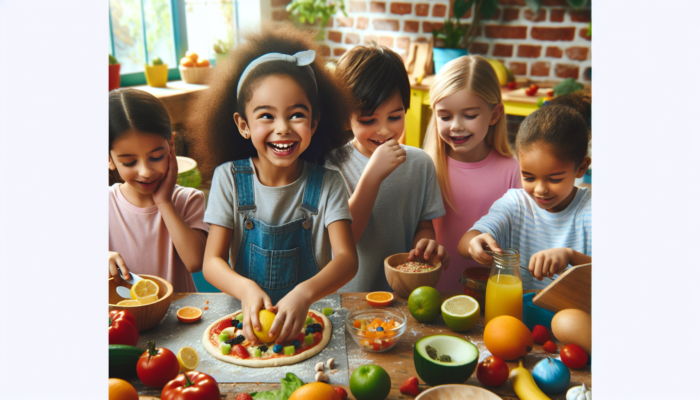Empower Children in the Kitchen: Effective Strategies for Cultivating Culinary Skills
Select Engaging and Easy Recipes to Spark Excitement

Engaging children in the wonderful world of cooking begins with the deliberate selection of recipes that are not only easy to follow but also immensely enjoyable. Choose straightforward meals like sandwiches or fruit salads, as these culinary delights can significantly enhance their confidence and enthusiasm to participate in the cooking process. By concentrating on uncomplicated dishes, children will quickly learn the fundamentals of cooking without feeling daunted by complex techniques or unfamiliar ingredients. This approach nurtures their culinary skills and fosters a sense of achievement as they successfully create meals from scratch, establishing a positive lifelong relationship with cooking.
Involving children in the recipe selection process is equally important. Allowing kids to participate in meal planning can dramatically increase their interest in cooking. When they feel included in the decision-making, they are more inclined to take ownership of the final result. For example, present a selection of options for a family meal and let them vote on their favourite dish. This interactive technique not only boosts their engagement but also educates them about food diversity and preferences across various cultures, enriching their culinary knowledge and expanding their palates.
Utilising familiar ingredients can transform the cooking experience into a more enjoyable and less intimidating task for children. When kids recognise the ingredients they’re working with, it alleviates anxiety and enhances their willingness to explore. Incorporating well-loved foods such as bananas, peanut butter, or cheese creates a comfortable cooking environment. This familiarity encourages them to express their creativity in the kitchen and inspires curiosity about alternative ways to use these ingredients in new and exciting recipes.
Prioritise Kitchen Safety for Young Aspiring Chefs
Ensuring safety in the kitchen is paramount when involving children in cooking activities. Educating youngsters on the proper handling of kitchen tools and appliances is crucial to preventing accidents and establishing responsible cooking habits. Teach them the correct techniques for using knives, operating mixers, and understanding the importance of being cautious around hot surfaces. This foundational knowledge empowers them to navigate the kitchen confidently and safely, fostering a secure environment for their culinary adventures.
Close supervision is vital while children engage in cooking tasks. Maintaining a watchful eye on them ensures compliance with safety protocols, such as keeping a safe distance from sharp tools and hot appliances. This oversight provides an excellent opportunity to reinforce what they’ve learned about kitchen safety, offering real-time coaching and guidance. By actively participating in their cooking experience, you can help them develop a deep understanding of the significance of safety in the kitchen, a lesson that will serve them well throughout their lives.
Utilising child-safe utensils is another essential step in creating a secure cooking environment. Providing tools specifically designed for children's use, such as plastic knives and heat-resistant bowls, can significantly reduce the risk of injury. These utensils are often easier for little hands to manage, making the cooking experience more enjoyable and less fraught with danger. Introducing them to these child-friendly tools empowers kids to tackle more complex culinary tasks as their skills develop, boosting their confidence in the kitchen.
Transform Cooking into a Fun and Educational Experience
Cooking can become a delightful educational adventure when approached with creativity. By integrating learning into the cooking process, children gain valuable insights into nutrition, measurements, and fundamental scientific concepts related to food preparation. For instance, discussing the importance of various food groups while preparing a balanced meal can provide essential lessons on healthy eating habits. Involving them in measuring ingredients offers practical applications of mathematics, enhancing their understanding in an enjoyable and engaging manner.
Incorporating cooking games can further enrich the experience, transforming a simple task into an exciting challenge. These games might include timed cooking races or themed cooking evenings where kids prepare dishes from diverse countries. Such creative activities make cooking enjoyable and stimulate creativity and teamwork. By presenting cooking in a game-like context, children are more likely to feel enthusiastic about participating, turning what could otherwise seem like a chore into a fun and rewarding activity.
Celebrating children's achievements in the kitchen is crucial for reinforcing their efforts and successes, no matter how small. Acknowledging their hard work fosters pride and accomplishment, motivating them to continue exploring the culinary world. Whether it’s a simple ‘great job’ or a festive family meal featuring their culinary creations, recognition is vital in encouraging ongoing participation. This positive reinforcement plays an instrumental role in cultivating a lifelong love for cooking and an appreciation for the joy it brings to family and friends.
Nurture Culinary Creativity and Exploration Among Young Cooks

Encouraging children to infuse their personal touch into recipes nurtures their creativity and instils a sense of ownership over their culinary creations. Allowing them to experiment with their ideas, whether it’s adding a splash of lemon juice to a fruit salad or selecting different toppings for a pizza, transforms cooking into a dynamic and personalised process. This freedom can lead to innovative dishes that reflect their unique tastes and preferences, ultimately boosting their confidence in the kitchen as they learn to trust their instincts.
Introducing kids to a variety of flavours can significantly broaden their culinary horizons. Encouraging them to experiment with different herbs and spices nurtures a love for diverse cuisines and helps develop a more refined palate. Consider taking them on a flavour journey by preparing recipes from various cultures around the globe, allowing them to discover how global ingredients can enhance a dish. This exploration not only expands their taste but also fosters an appreciation for cultural diversity and global food traditions, enriching their culinary education.
Teaching children how to present their dishes creatively can elevate meals into more visually appealing and enjoyable experiences. Kids can transform everyday meals into exciting visual delights by incorporating food art or themed decorations. For instance, they might create amusing faces using fruits and vegetables or arrange their meals to resemble their favourite characters. These imaginative presentations not only enhance the enjoyment of eating but also boost their pride in their culinary efforts, encouraging them to continue exploring their skills in the kitchen.
Encouraging kids to experiment with new cooking techniques can enrich their culinary skills and foster creativity. Whether it's grilling, steaming, or baking, exploring various methods allows them to appreciate the versatility of cooking. Each technique introduces new textures and flavours, helping them understand the science behind why certain methods work. Additionally, mastering different techniques equips them with the confidence to tackle more complex recipes in the future, further expanding their culinary repertoire and enhancing their cooking experience.
Instil the Importance of Kitchen Cleanliness and Hygiene
Maintaining cleanliness in the kitchen is essential, especially when involving children in cooking activities. Teaching kids to clean as they go cultivates a sense of responsibility and keeps the cooking environment tidy and hygienic. Encourage them to wipe down surfaces after spills and to put away ingredients promptly. This habit not only streamlines the cooking process but also minimises the risk of accidents caused by clutter, fostering good organisational skills in the kitchen and promoting a safe cooking environment.
Emphasising the importance of handwashing is critical for preventing the spread of germs. Instruct children to wash their hands regularly before, during, and after cooking, particularly after handling raw ingredients. This practice is a crucial lesson in personal hygiene that extends beyond the kitchen setting. Making handwashing fun—perhaps by singing a song during the wash—can encourage them to adopt this important habit enthusiastically, reinforcing the significance of cleanliness in all aspects of life and instilling lifelong hygiene practices.
Teaching children proper food storage is another vital component of maintaining kitchen cleanliness. Involving them in the correct storage of leftovers helps ensure food safety and reduces waste. Explain why certain foods must be refrigerated and how to label containers with dates. This knowledge enhances their understanding of food safety and instils respect for food and the resources required for its preparation, contributing to their overall culinary education.
Instructing kids to use clean utensils and surfaces prevents cross-contamination during meal preparation. Encourage them to wash cutting boards and utensils between uses, particularly when switching from raw to cooked foods. This practice not only ensures food safety but also teaches them about the importance of cleanliness in the kitchen. This lesson will benefit them throughout their lives, reinforcing their understanding of hygiene and safety in food preparation.
Promote Teamwork and Effective Communication in Culinary Activities
Cooking together can be a wonderful opportunity to cultivate teamwork among children. Assigning specific roles tailored to each child’s abilities and interests promotes collaboration and ensures everyone is actively engaged in cooking. For instance, one child could wash vegetables while another measures the ingredients. This division of tasks enhances efficiency and imparts valuable lessons about the importance of working together towards a shared goal, fostering a sense of community and cooperation.
Encouraging open communication among children while they cook is essential for effective teamwork. Promoting discussions about their tasks and any challenges they encounter enables kids to coordinate their efforts and solve problems collaboratively. This dialogue enhances their social skills and allows them to express their thoughts and ideas freely, building confidence in their communication abilities while teaching them the value of collaboration and teamwork in a fun setting.
Celebrating team efforts in the kitchen reinforces the significance of working together. Acknowledging the collective success of preparing a meal helps children appreciate the value of collaboration. Whether through a celebratory family meal or a fun cooking dance party once the dish is completed, these moments create cherished memories and foster a sense of community. Recognising the contributions of each child helps instil a spirit of teamwork that will benefit them throughout their lives, both in the kitchen and beyond.
Adapt Cooking Activities to Embrace Dietary Needs and Preferences

Cooking with children often requires adaptability to accommodate individual dietary needs and preferences. Understanding these requirements, whether due to allergies, intolerances, or specific dietary practices, is crucial to ensuring that everyone can enjoy the cooking experience. Engaging children in discussions about their dietary restrictions allows for creativity in the kitchen while prioritising health and safety, creating a supportive cooking environment.
When adapting recipes, consider substituting ingredients to cater to different dietary preferences. For instance, replacing dairy with non-dairy alternatives or selecting gluten-free options ensures that all children can participate fully in cooking. This flexibility encourages children to explore various ingredients, teaching them about the diversity of food options available worldwide and fostering an inclusive atmosphere in the kitchen that celebrates everyone's preferences.
Ensuring that everyone’s tastes are considered promotes inclusivity within the cooking experience. Involving children in discussions about their favourite foods empowers them to express their likes and dislikes, leading to a more enjoyable meal preparation process. This practice encourages open-mindedness and respect for different dietary preferences, essential lessons in today’s diverse culinary landscape, nurturing empathy and understanding among young cooks.
Finally, encouraging children to try new dishes while being mindful of their dietary restrictions teaches them to appreciate various cuisines. This exploration broadens their culinary horizons and fosters a lifelong love for cooking. By creating an inclusive environment where everyone’s dietary needs are respected and celebrated, cooking becomes more than just about food; it evolves into a celebration of community, creativity, and connection among family and friends.
Addressing Common Questions About Cooking with Kids
What are some straightforward recipes for kids to try out initially?
Start with basic recipes such as sandwiches, fruit salads, or pancakes. These uncomplicated dishes encourage children to engage with familiar ingredients while building their confidence in the kitchen and making cooking a fun experience.
How can I ensure my child remains safe while cooking?
Teach children the proper handling of kitchen tools, supervise closely, and provide child-safe utensils. Regularly reinforce safety guidelines to foster a secure cooking environment for young chefs, ensuring they understand the importance of caution.
What should I do if my child is picky about their food choices?
Involve them in meal planning and preparation. Allow them to select recipes that incorporate their favourite ingredients, encouraging them to try new foods while remaining connected to familiar tastes, which can help expand their culinary preferences.
How can I make cooking an educational experience for my child?
Utilise cooking to teach about nutrition, measurements, and scientific concepts. Engage children with hands-on activities that relate to their current studies or interests, making learning enjoyable and practical while reinforcing essential life skills.
What are some entertaining cooking games for kids?
Try timed cooking challenges, themed cooking nights, or develop a friendly competition. These activities turn cooking into a playful experience, fostering enthusiasm, teamwork, and creativity among young chefs, making the experience enjoyable and engaging.
How can I instil food hygiene practices in my child?
Emphasise the importance of hand washing, cleaning surfaces, and using clean utensils. Teach them about proper food storage practices to prevent spoilage and foodborne illnesses, reinforcing good hygiene habits that are crucial in the kitchen.
What if my child has dietary restrictions?
Be flexible with ingredients to accommodate any allergies or intolerances. Discuss dietary needs openly and explore alternative ingredients that allow everyone to safely participate in the cooking process, ensuring inclusivity and safety for all.
How can cooking strengthen family bonds?
Cooking together fosters teamwork, communication, and shared experiences. It creates lasting memories and encourages collaboration in a fun, engaging environment that nurtures family connections and strengthens relationships.
What are some creative methods to present food attractively?
Encourage kids to utilise food art, create themed dishes, or arrange food in fun shapes. This approach makes meals more appealing and enhances their pride in their culinary efforts, encouraging them to be creative and imaginative.
How can I inspire my child to be more adventurous in cooking?
Encourage experimentation with new flavours, cooking techniques, and cuisines. Celebrate their creativity and successes, reinforcing their confidence to explore culinary avenues and ideas, fostering a love for cooking and discovery.
Stay connected and updated with our exciting content on Facebook!
The post Top Tips for Cooking with Kids in Mind: A Family-Friendly Guide appeared first on https://cookinggods.com
The Article Cooking with Kids: Essential Tips for Family-Friendly Meals Was Found On https://limitsofstrategy.com

